-
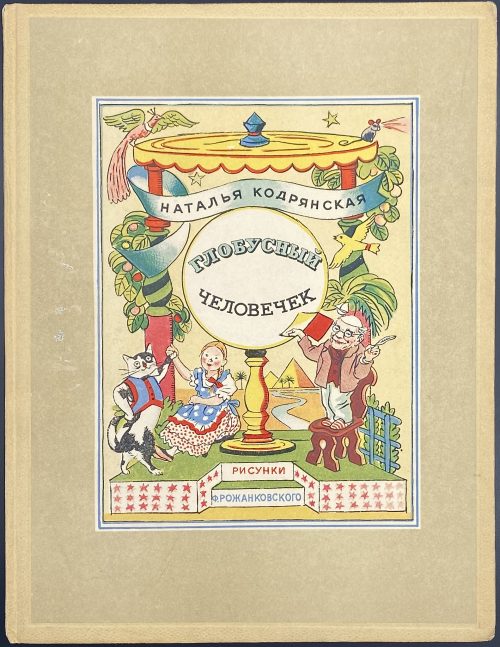 Hardcover volume, 27.8 x 21.4 cm, bound in tan buckram with pictorial paper pasted to front and back boards, brown lettering to spine; pp: fep, [1-6] 7-67 [68] [2] ffl, fep, total 37 leaves; 5 full-page plates, incl. frontispiece (within pagination), covers’ and t.p. vignettes, headpieces, in-text illustrations (eleven in total) chromolithographs after Rojankovsky; the tailpieces are photomechanically reproduced. Title-page (in colour): НАТАЛЬЯ КОДРЯНСКАЯ | ГЛОБУСНЫЙ | ЧЕЛОВЕЧЕК | {vignette} | ИЛЛЮСТРАЦИИ ФЕДОРА РОЖАНКОВСКОГО || Colophon: CET OUVRAGE | A ÉTÉ IMPRIMÉ A PARIS | LA LITHOGRAPHIE | PAR MOURLOT FRÈRES | LA TYPOGRAPHIE | PAR L’IMPRIMERIE UNION | {blank}] | TOUS DROITS RÉSERVÉS POUR PAYS | COPYRIGHT 1954 BY NATALIE CODRAY | Printed in France || Contributors: Наталья Владимировна Кодрянская [Natalie Codray] (Russian-American, 1901 – 1983) – author. Feodor Rojankovsky [Rojan, Фёдор Степанович Рожанковский] (Russian-American, 1891 – 1970) – artist. Mourlot Frères – printer/lithographs. L’imprimerie Union – printer/text.
Hardcover volume, 27.8 x 21.4 cm, bound in tan buckram with pictorial paper pasted to front and back boards, brown lettering to spine; pp: fep, [1-6] 7-67 [68] [2] ffl, fep, total 37 leaves; 5 full-page plates, incl. frontispiece (within pagination), covers’ and t.p. vignettes, headpieces, in-text illustrations (eleven in total) chromolithographs after Rojankovsky; the tailpieces are photomechanically reproduced. Title-page (in colour): НАТАЛЬЯ КОДРЯНСКАЯ | ГЛОБУСНЫЙ | ЧЕЛОВЕЧЕК | {vignette} | ИЛЛЮСТРАЦИИ ФЕДОРА РОЖАНКОВСКОГО || Colophon: CET OUVRAGE | A ÉTÉ IMPRIMÉ A PARIS | LA LITHOGRAPHIE | PAR MOURLOT FRÈRES | LA TYPOGRAPHIE | PAR L’IMPRIMERIE UNION | {blank}] | TOUS DROITS RÉSERVÉS POUR PAYS | COPYRIGHT 1954 BY NATALIE CODRAY | Printed in France || Contributors: Наталья Владимировна Кодрянская [Natalie Codray] (Russian-American, 1901 – 1983) – author. Feodor Rojankovsky [Rojan, Фёдор Степанович Рожанковский] (Russian-American, 1891 – 1970) – artist. Mourlot Frères – printer/lithographs. L’imprimerie Union – printer/text. -
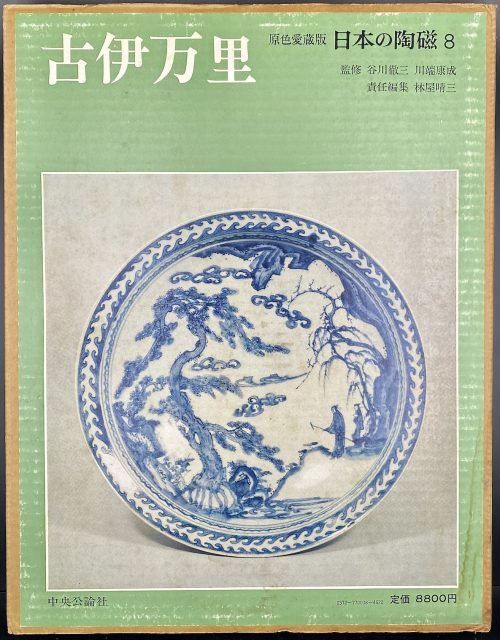 Hardcover volume, 35.1 x 27 cm, bound in grey cloth, blind stamped characters to front, brown characters to spine, in a glassine dust jacket, in a double slipcase, the outer case pictorial paper over cardboard, 36 x 27.8 cm, pp.: [4] [1] 2-108 (plates with photographs of 217 items), [2] [111] 112-150 [3]. Imari ware [伊万里焼] (Imari-yaki) – ceramics produced in and around the area of Arita, in the former Hizen Province, northwestern Kyūshū. 日本の陶磁 – Japanese ceramics, series title. Old imari [古伊万里] (koimari) – book title. Contributors: Yasunari Kawabata [川端 康成] (Japanese, 1924 – 1972) – author. Tetsuzo Tanikawa [谷川 徹三] (Japanese, 1895 – 1989) – author. Seizo Hayashiya [林屋晴三] (Japanese, 1928 – 2017) – editor. Chūōkōron-sha [中央公論社] – publisher.
Hardcover volume, 35.1 x 27 cm, bound in grey cloth, blind stamped characters to front, brown characters to spine, in a glassine dust jacket, in a double slipcase, the outer case pictorial paper over cardboard, 36 x 27.8 cm, pp.: [4] [1] 2-108 (plates with photographs of 217 items), [2] [111] 112-150 [3]. Imari ware [伊万里焼] (Imari-yaki) – ceramics produced in and around the area of Arita, in the former Hizen Province, northwestern Kyūshū. 日本の陶磁 – Japanese ceramics, series title. Old imari [古伊万里] (koimari) – book title. Contributors: Yasunari Kawabata [川端 康成] (Japanese, 1924 – 1972) – author. Tetsuzo Tanikawa [谷川 徹三] (Japanese, 1895 – 1989) – author. Seizo Hayashiya [林屋晴三] (Japanese, 1928 – 2017) – editor. Chūōkōron-sha [中央公論社] – publisher. -
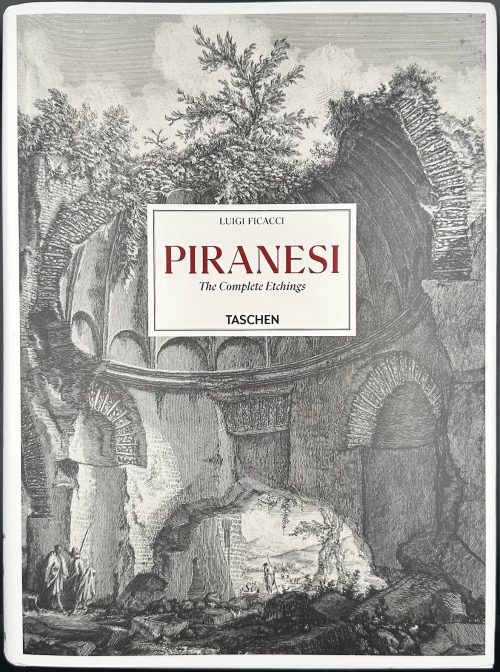 Hardcover volume, 35 x 26 cm, bound in pictorial paper boards with a lettered label to front cover, black lettering to spine, pictorial dust jacket, pictorial endpapers, pp.: [1-5] 6-787 [788], 1028 colour ils., trilingual edition (English, German, French). Title-page (red and black): LUIGI FICACCI | ISTITUTO NAZIONALE PER LA GRAFICA, ROME | Giovanni Battista | PIRANESI | Catalogue of the Complete Etchings | Gesamtkatalog der Radierungen | Catalogue raisonné des eaux-fortes | TASCHEN || Contributors: Luigi Ficacci (Italian, b. 1954) – author. Giovanni Battista [Giambattista] Piranesi (Italian, 1720 – 1778) – artist.
Hardcover volume, 35 x 26 cm, bound in pictorial paper boards with a lettered label to front cover, black lettering to spine, pictorial dust jacket, pictorial endpapers, pp.: [1-5] 6-787 [788], 1028 colour ils., trilingual edition (English, German, French). Title-page (red and black): LUIGI FICACCI | ISTITUTO NAZIONALE PER LA GRAFICA, ROME | Giovanni Battista | PIRANESI | Catalogue of the Complete Etchings | Gesamtkatalog der Radierungen | Catalogue raisonné des eaux-fortes | TASCHEN || Contributors: Luigi Ficacci (Italian, b. 1954) – author. Giovanni Battista [Giambattista] Piranesi (Italian, 1720 – 1778) – artist. -
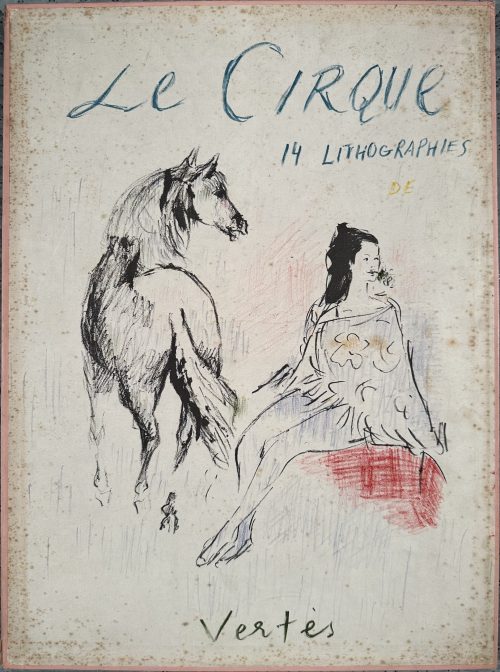 Publisher’s peach cloth box 555 x 410 mm with coloured lithograph on the lid, autographed with crayons "Le Cirque | 14 LITHOGRAPHIES | DE | {vignette} | Vertes"; in-folio unbound 4 pp. booklet on laid paper watermarked “Marais” and 14 loose leaves of plates on laid paper 520 x 395 mm without a watermark with coloured lithographs signed “Vertes” and numbered “195/250” in pencil; interleaved with tracing paper. Box and plates foxed. Title-page (red and black): LE | CIRQUE | 14 LITHOGRAPHIES DE | VERTÈS | PRÉSENTÉ | PAR | JEAN COCTEAU || Imprint: LES LIVES MERVEILLEUX | MONACO | Il a été tiré de cet album : | 150 Exemplaires, | destinés à | l'Amérique, | distribués bar les soins de | Arthur H. Harlow | de New-York, | & | 100 Exemplaires, | réservés à la France. | 15 Avril 1949 || Limitation: Edition limited to 250 copies (150 for USA, 100 for France); this is copy № 195 printed for France as the American copies marked “Published by Arthur H. Harlow & Co., New York. Seller’s Description: VERTÈS, Marcel (Hungarian-French, 1895-1961). Le Cirque 14 Lithographies de Vertès. Présénte par Jean Cocteau. [Monaco: Les Livres Merveilleux, 1949]. [vi] pp. With all 14 lithographs, each signed by the artist and numbered “195/250”. Text and lithographs 15 ¼ x 20 ½”. In original publisher’s peach cloth box with printed label on lid (box foxed, soiled, lightly worn; lithographs and text foxed). Still, a very good example of this lovely collection, with an introduction by Jean Cocteau (1889-1963). Catalogue Raisonné: Vokaer № 50. Marcel Vertès [Marcell Vértes] (Jewish-Hungarian-French, 1895 – 1961) – artist. Arthur H. Harlow (American, c. 1877 – 1958) – publisher. Jean Cocteau (French, 1889 – 1963) – author.
Publisher’s peach cloth box 555 x 410 mm with coloured lithograph on the lid, autographed with crayons "Le Cirque | 14 LITHOGRAPHIES | DE | {vignette} | Vertes"; in-folio unbound 4 pp. booklet on laid paper watermarked “Marais” and 14 loose leaves of plates on laid paper 520 x 395 mm without a watermark with coloured lithographs signed “Vertes” and numbered “195/250” in pencil; interleaved with tracing paper. Box and plates foxed. Title-page (red and black): LE | CIRQUE | 14 LITHOGRAPHIES DE | VERTÈS | PRÉSENTÉ | PAR | JEAN COCTEAU || Imprint: LES LIVES MERVEILLEUX | MONACO | Il a été tiré de cet album : | 150 Exemplaires, | destinés à | l'Amérique, | distribués bar les soins de | Arthur H. Harlow | de New-York, | & | 100 Exemplaires, | réservés à la France. | 15 Avril 1949 || Limitation: Edition limited to 250 copies (150 for USA, 100 for France); this is copy № 195 printed for France as the American copies marked “Published by Arthur H. Harlow & Co., New York. Seller’s Description: VERTÈS, Marcel (Hungarian-French, 1895-1961). Le Cirque 14 Lithographies de Vertès. Présénte par Jean Cocteau. [Monaco: Les Livres Merveilleux, 1949]. [vi] pp. With all 14 lithographs, each signed by the artist and numbered “195/250”. Text and lithographs 15 ¼ x 20 ½”. In original publisher’s peach cloth box with printed label on lid (box foxed, soiled, lightly worn; lithographs and text foxed). Still, a very good example of this lovely collection, with an introduction by Jean Cocteau (1889-1963). Catalogue Raisonné: Vokaer № 50. Marcel Vertès [Marcell Vértes] (Jewish-Hungarian-French, 1895 – 1961) – artist. Arthur H. Harlow (American, c. 1877 – 1958) – publisher. Jean Cocteau (French, 1889 – 1963) – author. -
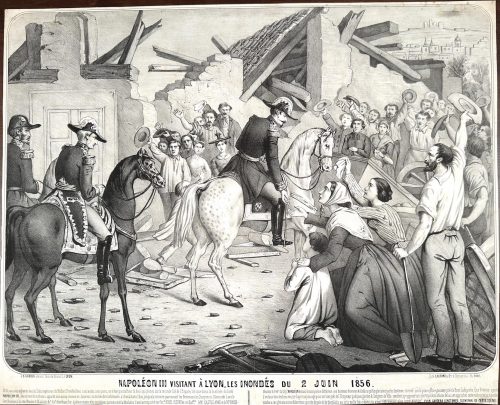 Lithography poster on wove paper, 492 x 614 mm; black ink stamp “5036” to reverse, vertical centerfold. Image in frame; under the frame left: "J. B. Gadola, éditeur. Cours de Brosses 1, à LYON."; right: "Lith LAURANT & Cie r. de Bernardins 34, Paris." Title and text below the image. Jean-Baptiste Gadola (French, 1818 – 1870) – publisher.
Lithography poster on wove paper, 492 x 614 mm; black ink stamp “5036” to reverse, vertical centerfold. Image in frame; under the frame left: "J. B. Gadola, éditeur. Cours de Brosses 1, à LYON."; right: "Lith LAURANT & Cie r. de Bernardins 34, Paris." Title and text below the image. Jean-Baptiste Gadola (French, 1818 – 1870) – publisher. -
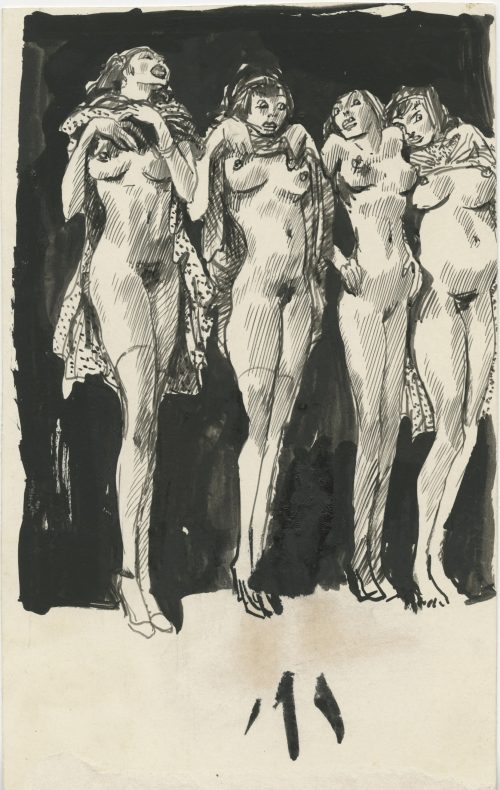 Drawing on both sides; Pen and wash, india ink, gouache, on cardboard, 225 x 140 mm, black ink stamp to verso: “Nachlaß O R SCHATS”, remnants of hinges. Attributed to Otto Rudolf Schatz (Austrian, 1900 – 1961).
Drawing on both sides; Pen and wash, india ink, gouache, on cardboard, 225 x 140 mm, black ink stamp to verso: “Nachlaß O R SCHATS”, remnants of hinges. Attributed to Otto Rudolf Schatz (Austrian, 1900 – 1961). -
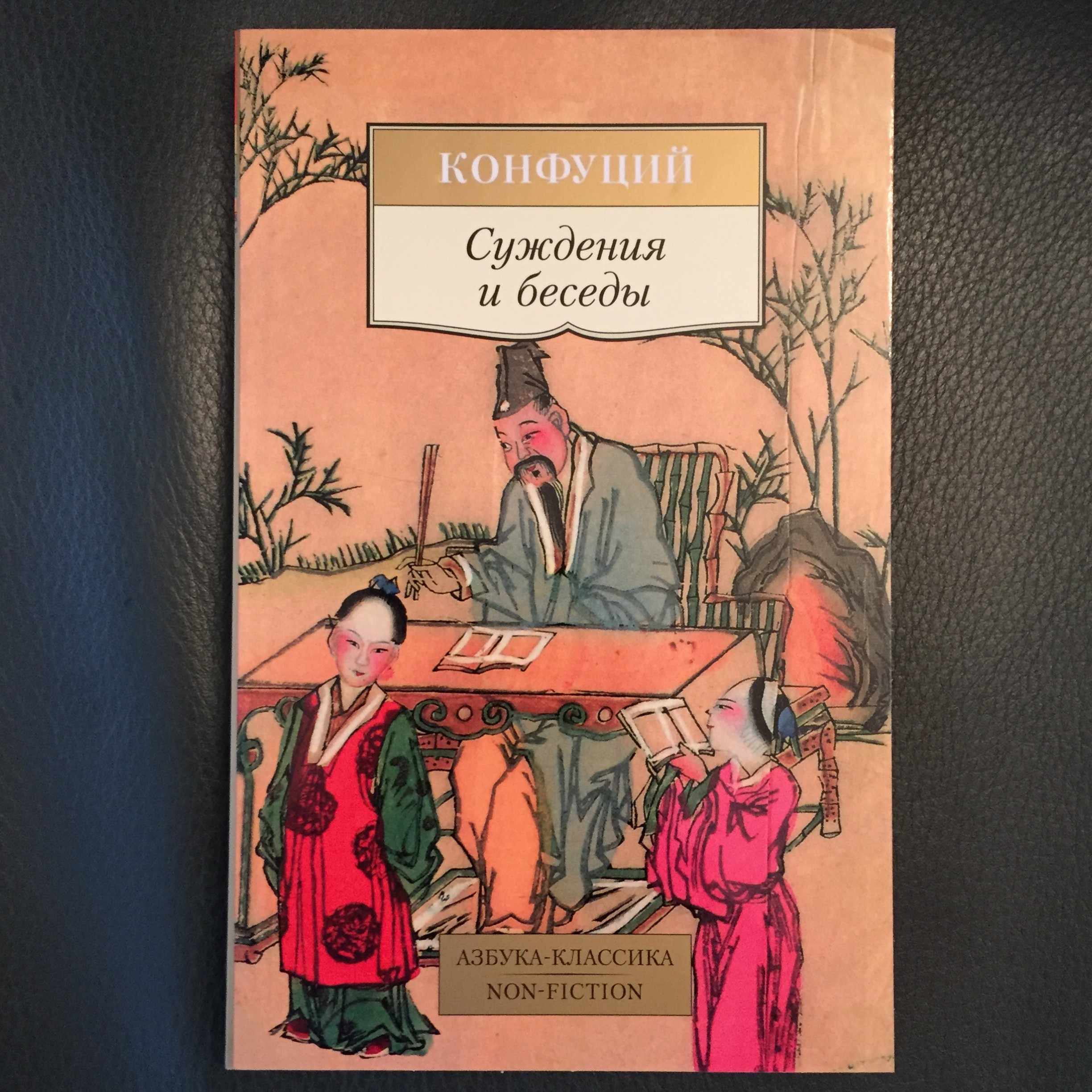
Конфуций. Суждения и беседы. Пер. с кит. П. С. Попова. - СПб.: Азбука-Аттикус, 2015. - 224 с. (Азбука-Классика. Non-Fiction). ISBN 978-5-389-09738-4.
-
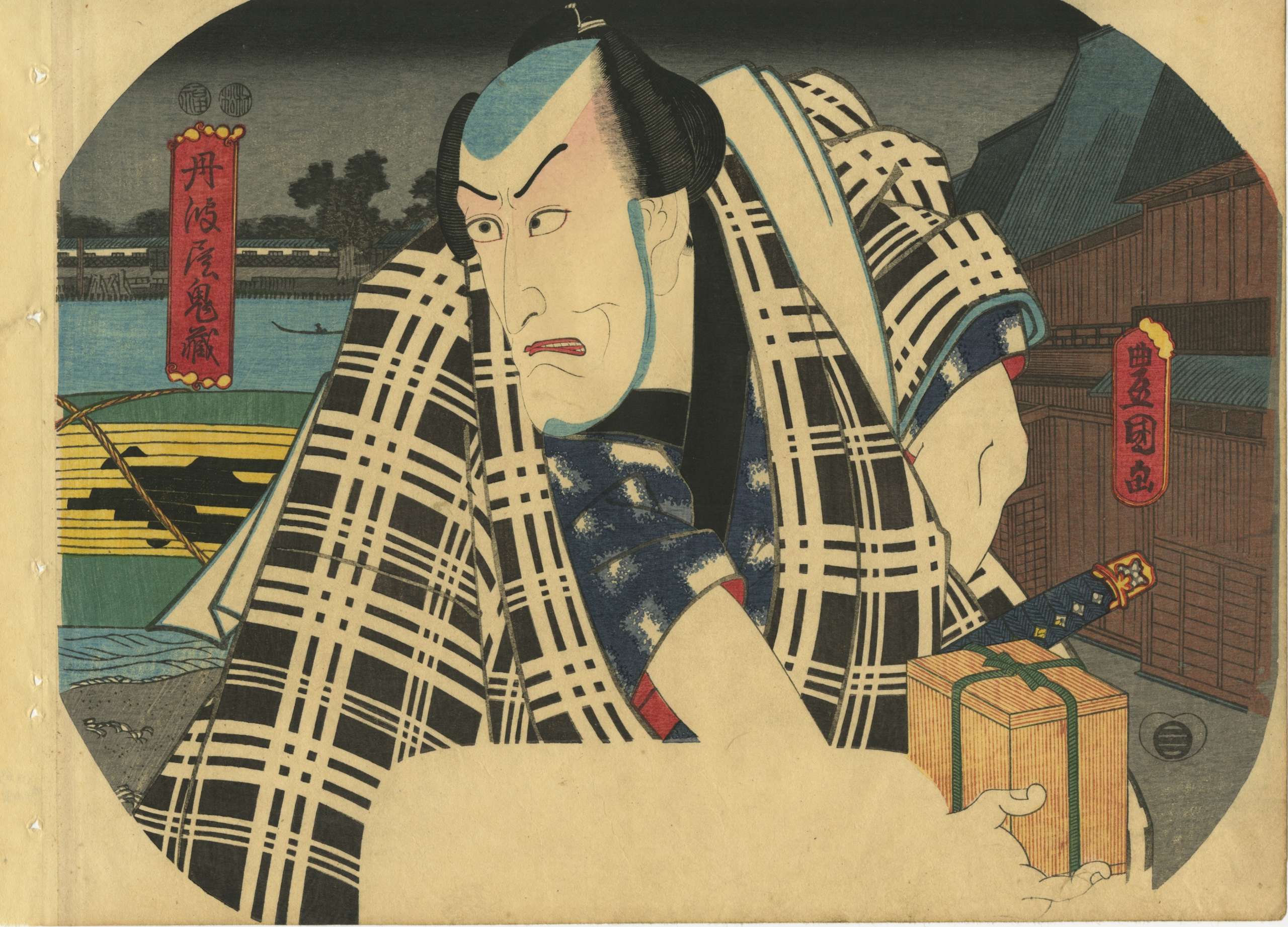 Artist: Utagawa Kunisada [歌川 国貞] a.k.a. Utagawa Toyokuni III [三代歌川豊国] (Japanese, 1786 – 1865). Signed: Toyokuni ga [豊国 画] in a red toshidama cartouche. Actor: Ichikawa Danjūrō VII 市川団十郎 (Japanese, 1791 – 1859); other names: Ichikawa Ebizō V, Ichikawa Hakuen II, Ichikawa Shinnosuke I. Character: Tanbaya Onizo [丹波屋鬼蔵] Play: Koi Bikyaku Yamato Orai [恋飛脚大和往来] Performance: Kawarasaki Theatre [河原崎座] in the 2nd month of 1851. Double nanushi censor seals: Fuku & Muramatsu, from 3rd month of Kaei 2 to 11th month of Kaei 4 (1849-51). Another fan print from the pair SVJP-0212-2.2016: Sawamura Chōjūrō V as Kameya Chubei.
Artist: Utagawa Kunisada [歌川 国貞] a.k.a. Utagawa Toyokuni III [三代歌川豊国] (Japanese, 1786 – 1865). Signed: Toyokuni ga [豊国 画] in a red toshidama cartouche. Actor: Ichikawa Danjūrō VII 市川団十郎 (Japanese, 1791 – 1859); other names: Ichikawa Ebizō V, Ichikawa Hakuen II, Ichikawa Shinnosuke I. Character: Tanbaya Onizo [丹波屋鬼蔵] Play: Koi Bikyaku Yamato Orai [恋飛脚大和往来] Performance: Kawarasaki Theatre [河原崎座] in the 2nd month of 1851. Double nanushi censor seals: Fuku & Muramatsu, from 3rd month of Kaei 2 to 11th month of Kaei 4 (1849-51). Another fan print from the pair SVJP-0212-2.2016: Sawamura Chōjūrō V as Kameya Chubei.
-
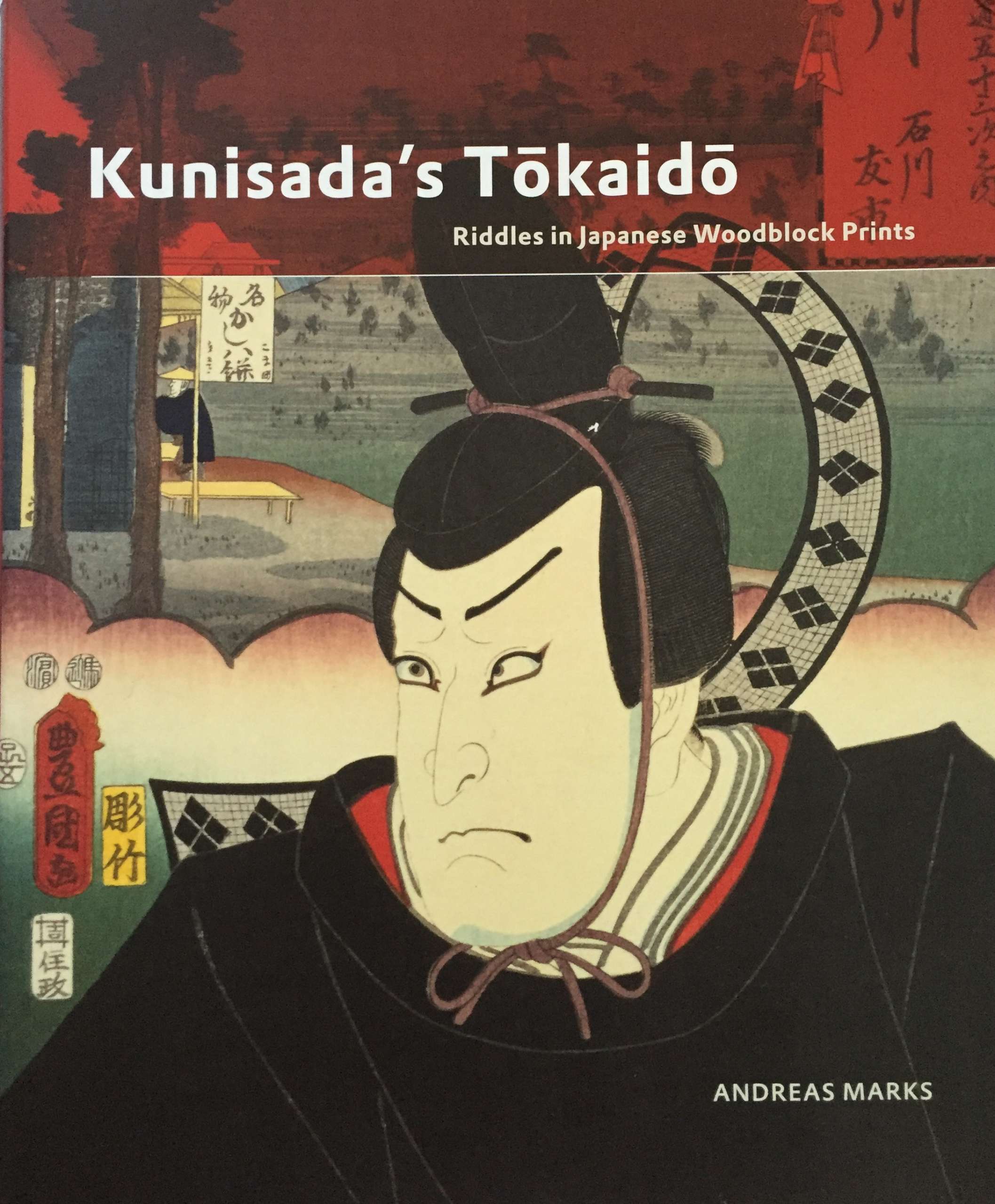 Hardcover, white lettered boards, pictorial DJ, pp.: [1-8] 9-359 [360 blank].
Hardcover, white lettered boards, pictorial DJ, pp.: [1-8] 9-359 [360 blank].ISBN: 9789004191464.
-
 Iron tsuba of round form (width > height) decorated with a squirrel (on the face) and bamboo (on the reverse) motif in sahari flat inlay (hira-zōgan). Signed: Hazama (間) Size: 75.1mm x 75.9mm, thickness of seppa-dai 5.4mm. Early 18th century, mid Edo. Haynes/Torigoye: "There is another name for Hazama tsuba: the Kameyama school. In the period from Hōei to Kyōhō (1704-36) at Kameyama, in the province of Ise, the Kunitomo family made this style of tsuba" [...] The two artists who are best known for the sahari style of inlaid tsuba are Sadahide and Masahide" [...] The signature Hazama should be considered as that of Masahide". Sahari inlay is the distinctive characteristics of Hazama school. Sahari is an alloy of copper, tin, lead, zinc and silver. Hazama tsuba was carved patterns at first, then poured heated into the carvings on iron ground. Because it is an alloy, sahari shows different colors in each tsuba. According to Merrily Baird [Symbols, p. 163], "squirrels (risu) ... have no symbolic importance". NBTHK certificate №448388.
Iron tsuba of round form (width > height) decorated with a squirrel (on the face) and bamboo (on the reverse) motif in sahari flat inlay (hira-zōgan). Signed: Hazama (間) Size: 75.1mm x 75.9mm, thickness of seppa-dai 5.4mm. Early 18th century, mid Edo. Haynes/Torigoye: "There is another name for Hazama tsuba: the Kameyama school. In the period from Hōei to Kyōhō (1704-36) at Kameyama, in the province of Ise, the Kunitomo family made this style of tsuba" [...] The two artists who are best known for the sahari style of inlaid tsuba are Sadahide and Masahide" [...] The signature Hazama should be considered as that of Masahide". Sahari inlay is the distinctive characteristics of Hazama school. Sahari is an alloy of copper, tin, lead, zinc and silver. Hazama tsuba was carved patterns at first, then poured heated into the carvings on iron ground. Because it is an alloy, sahari shows different colors in each tsuba. According to Merrily Baird [Symbols, p. 163], "squirrels (risu) ... have no symbolic importance". NBTHK certificate №448388. -
 The chrysanthemoid (kiku-gata) iron plate with polished surface decorated with arabesque (karakusa) and paulownia (kiri) leaves and flowers in brass, copper and silver flush inlay (hira-zōgan) on both sides. Some of the inlay goes over the edge. Kozuka- and kogai-hitsu-ana are filled with lead plugs. Sekigane of copper. Chrysanthemum and paulownia are the symbols of imperial family. The face is signed: Izumi no Kami to the right of nakago-ana, and Yoshiro on the left; the back is signed Koike Naomasa. His signed work is considered by many experts to have been made-to-order only. The original wooden box (tomobako) with inscription (hakogaki) signed by Dr. Kazutaro Torigoye and dated Showa 39 (1964). The late Muromachi or Momoyama period, 16th century. Dimensions: 89 mm x 84 mm x 3.6 mm; Weight: 170 g. Hakogaki lid: Yoshirō kikka-gata Hakogaki lid inside: Iron, signed on the omote: Izumi no Kami – Yoshirō; on the ura: Koike Naomasa. Kikka-gata, pronounced maru-mumi, two hitsu-ana, karakusa, and kiri design in brass, silver, and suaka hira-zōgan. Height 8.5 cm, thickness 3.5 mm. Herewith I judge this work as authentic. On a lucky day in July of 1964. Torigoe Kōdō [Kazutarō] + kaō According to Robert Haynes [Catalog #7, 1983; №32, page 42-43] "This full form of the signature is seen very rarely". His example, illustrated in that catalogue, measures: height = 86 mm, thickness at seppa-dai = 3.75 mm and signed Izumi no Kami Yoshiro on the back and Koike Naomasa on the face. The further description of his specimen by Robert Haynes:
The chrysanthemoid (kiku-gata) iron plate with polished surface decorated with arabesque (karakusa) and paulownia (kiri) leaves and flowers in brass, copper and silver flush inlay (hira-zōgan) on both sides. Some of the inlay goes over the edge. Kozuka- and kogai-hitsu-ana are filled with lead plugs. Sekigane of copper. Chrysanthemum and paulownia are the symbols of imperial family. The face is signed: Izumi no Kami to the right of nakago-ana, and Yoshiro on the left; the back is signed Koike Naomasa. His signed work is considered by many experts to have been made-to-order only. The original wooden box (tomobako) with inscription (hakogaki) signed by Dr. Kazutaro Torigoye and dated Showa 39 (1964). The late Muromachi or Momoyama period, 16th century. Dimensions: 89 mm x 84 mm x 3.6 mm; Weight: 170 g. Hakogaki lid: Yoshirō kikka-gata Hakogaki lid inside: Iron, signed on the omote: Izumi no Kami – Yoshirō; on the ura: Koike Naomasa. Kikka-gata, pronounced maru-mumi, two hitsu-ana, karakusa, and kiri design in brass, silver, and suaka hira-zōgan. Height 8.5 cm, thickness 3.5 mm. Herewith I judge this work as authentic. On a lucky day in July of 1964. Torigoe Kōdō [Kazutarō] + kaō According to Robert Haynes [Catalog #7, 1983; №32, page 42-43] "This full form of the signature is seen very rarely". His example, illustrated in that catalogue, measures: height = 86 mm, thickness at seppa-dai = 3.75 mm and signed Izumi no Kami Yoshiro on the back and Koike Naomasa on the face. The further description of his specimen by Robert Haynes:"Early signed example of the work of Koike Naomasa. The kiku shape iron plate is well finished. The flush inlay is brass, for the scroll work on both sides, with the leaves and kiri mon in brass, copper and silver with strong detail carving. Some of the inlay goes almost over the edge, which is goishi gata. The large hitsuana are plugged in lead with starburst kokuin surface design. [...]The face is signed in deep bold kanji: Koike Naomasa; the back is signed: Izumi no Kami, on the right and Yoshiro on the left. There are one or two small pieces of inlay missing. Sold by Sotheby London, Oct. 27, 1981, lot 368. Height = 86 mm, thickness (seppa-dai) = 3.75 mm, (edge) = 4 mm."
Another similar example presented at: "Tsuba" by Günter Heckmann, 1995, №T55 — "Designation: Koike Naomasa. Mid Edo, end of the 17th century. Iron, hira-zogan in brass, copper, silver and shakudo, katakiri-bori. Tendrils and leaves. 87.0 x 78.0 x 4.0 mm." Reference: Japanische Schwertzierate by Lumir Jisl, 1967, page. 13. [SV: Actually, his tsuba is signed Izumi no Kami Yoshiro on the back; and Koike Naomasa on the front, exactly as Robert Haynes's tsuba. Dating this tsuba Mid-Edo, 17th century may be considered a misattribution]. More details regarding the Yoshirō tsuba. -
 An iron tsuba of 12-lobed form with alternating four solid and four openwork areas, each with a central bar. Symbolism remains unclear, possibly - a gunbai, i.e. military leader's fan. The solid parts decorated with 5 to 6 rows of brass dots of nail heads inlaid in ten-zōgan. The center of the plate as well as the sukashi elements are outlined with brass wire. The kozuka-hitsu-ana seems original. Muromachi period. Dimensions: 77.9 x 77.5 x 3.2 mm.
An iron tsuba of 12-lobed form with alternating four solid and four openwork areas, each with a central bar. Symbolism remains unclear, possibly - a gunbai, i.e. military leader's fan. The solid parts decorated with 5 to 6 rows of brass dots of nail heads inlaid in ten-zōgan. The center of the plate as well as the sukashi elements are outlined with brass wire. The kozuka-hitsu-ana seems original. Muromachi period. Dimensions: 77.9 x 77.5 x 3.2 mm. -

Iron tsuba of mokko form with rough surface decorated in low relief carving (sukidashi-bori) and openwork (sukashi) with a flying bat, a crescent moon, and a cloud over the moon. Bat's eyes inlaid with gold. Crescent moon and cloud on the reverse. Copper sekigane. Kogai hitsu-ana plugged with shakudō.
Unsigned.
Edo period.Size: Height: 83.7 mm; Width: 80.3 mm; Thickness: 2.9 mm; Weight: 141 g.
-
 Iron tsuba of octafoil form with design of rudder (kaji) and lake in openwork (sukashi) outlined with brass wire. Thin plate also decorated with three concentric circular rows of brass dots (nail heads) in ten-zōgan. Center of the plate outlined with the inlaid circular brass wire. Cut-outs for kozuka and kogai probably added later. Slightly raised rim between the indentations (suki-nokoshi-mimi). The inlaid metal of red-ish hue, so it may be copper, not brass. Sekigane, visible on the NBTHK paper photo, are missing, possibly removed by a previous owner. Muromachi period. Ōnin school. Unsigned. Dimensions: 81.2 mm x 81.8 mm x 2.7 mm. Weight: 79.0 g. Large nakago-ana: 34 mm high and 10 mm wide. NBTHK certificate №455786: Hozon. Note regarding design: it was quite hard to interpret the big oval opening. The first suggestion was 'sea cucubmer', and it was based on a design published by Kazutaro Torigoye [Kodogu and tsuba. International collections not published in my books (Toso Soran), 1978] on page 202: Katchūshi tsuba: Sea cucumber and butterfly. Look and judge yourself:The second suggestion - 'lake' - came from [Iron tsuba. The works of the exhibition "Kurogane no hana", The Japanese Sword Museum, 2014], page 14 №5:
Iron tsuba of octafoil form with design of rudder (kaji) and lake in openwork (sukashi) outlined with brass wire. Thin plate also decorated with three concentric circular rows of brass dots (nail heads) in ten-zōgan. Center of the plate outlined with the inlaid circular brass wire. Cut-outs for kozuka and kogai probably added later. Slightly raised rim between the indentations (suki-nokoshi-mimi). The inlaid metal of red-ish hue, so it may be copper, not brass. Sekigane, visible on the NBTHK paper photo, are missing, possibly removed by a previous owner. Muromachi period. Ōnin school. Unsigned. Dimensions: 81.2 mm x 81.8 mm x 2.7 mm. Weight: 79.0 g. Large nakago-ana: 34 mm high and 10 mm wide. NBTHK certificate №455786: Hozon. Note regarding design: it was quite hard to interpret the big oval opening. The first suggestion was 'sea cucubmer', and it was based on a design published by Kazutaro Torigoye [Kodogu and tsuba. International collections not published in my books (Toso Soran), 1978] on page 202: Katchūshi tsuba: Sea cucumber and butterfly. Look and judge yourself:The second suggestion - 'lake' - came from [Iron tsuba. The works of the exhibition "Kurogane no hana", The Japanese Sword Museum, 2014], page 14 №5:
Torigoye: sea cucumber and butterfly.
Opening on my tsuba looks more like the 'lake'. Also, rudder and lake make more sense than rudder and sea cucumber. At least to me...
Ko-Katchūshi tsuba: Lake and pine.
-

Iron tsuba of round form decorated with eight roundels – circular emblems of flowers and/or family crests (mon) made of cast brass, pierced and chiseled in kebori, and with flat brass inlay (hira-zōgan) of vines or leaves all over the plate. Both hitsu-ana could have been trimmed with brass now lacking. Nakago-ana of triangular form, possibly enlarged, with copper sekigane. All typical emblems with bellflower, two variations on suhama theme, and 3, 4, 5, and 6-poinitng mon variations. A distinctive character of this tsuba is a mon at 12 hours depicting water plantain (omodaka).
“Omodaka was also called shōgunsō (victorious army grass); because of this martial connotation, it was a design favored for the crests of samurai families” [Family crests of Japan, Stone Bridge Press, Berkeley, California]. Yoshirō school (Kaga-Yoshirō). The Momoyama or early Edo period, beginning of 17th century. Size: Height: 81.4 mm; width: 81.2; thickness 3.8 mm at seppa-dai. -
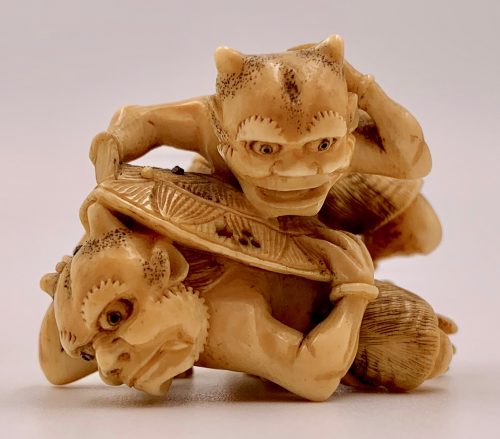
Ivory netsuke with the design of wrestling Oni by Kaigyokusai Masatsugu [懐玉齋正次].
Signed: Masatsugu [正次] Osaka School. Made: 1850-1900; Late Edo - Meiji Period. Dimensions: 44 x 40 x 33 mm.The right hand of the upper Oni and one toe of the lower Oni are missing. Ref.: Raymond Bushell. Collector's netsuke. Weatherhill, NY, Tokyo; Ninth printing, 2002, pp. 84-87. "Kaigyokusai Masatsugu (1813-1892) was an Osaka based carver renowned for his flawless technique as illustrated upon this netsuke with its finely carved ivory form, with no staining and bright inlaid eyes" (V&A).
-
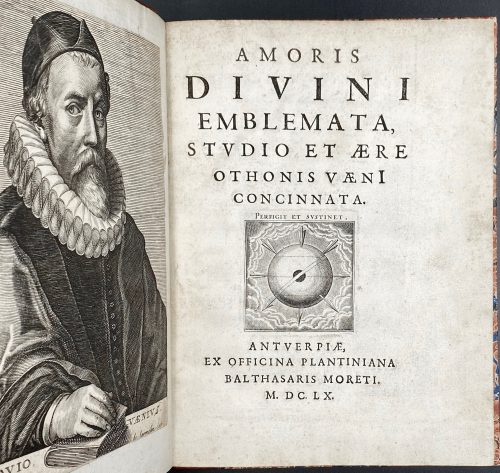 Amoris Divini Emblemata, Studio Et Aere Othonis Vaeni Concinata. — Antverpiae: Ex Officina Plantiniana Balthasaris Moreti, MDCLX [1660]. — pp.: [1] (Van Veen port.), [1] title, [2] (Isabella port.), 3-127 [1], 60 illustr. — 2nd impression. Octavius Vaenius, a.k.a. Otto Vaenius or Otto Van Veen (c. 1556-1629) was Rubens's last and most influential teacher. The Amoris divini emblemata was first published in 1615 by Nutius & Meursius in Antwerp. Vaenius’s book was to influence Herman Hugo's Pia desideria (LIB-1657.2018). Book structure: On frontispiece, trimmed and mounted portrait of Octavius Vaenius painted by his daughter Gertruida van Veen (signed Gertrudis filia) and engraved by Nicolas de Larmessin. Trimmed portrait of the Infanta Isabella Clara of Austria (1566 – 1633) pained by Peter Paul Rubens and engraved by Jan de Leeuw mounted to title verso. 60 engraved plates with emblems are on recto pages with facing texts: Latin quotations from Bible and Fathers, Spanish verses by Alphonso de Ledesma, Dutch by Vaenius and French by Carolus Philippus Hattron (d. 1632). Rebound in the mid-19th century in brown quarter Morocco with blind marbled boards and gilt lettering to spine. Inscription in ink on verso to van Veen portrait: "I bought this volume with the portraits inserted at the sale of the library of my uncle Samuel Rogers, Esq." Signed: "Frederick Sharpe, 1856". Frederick Sharpe (born was a son of Samuel Sharpe (1799–1881), the nephew of Samuel Rogers (1763–1855), a celebrated English poet. Size: 23.3 x 17.9 cm. Ref.: Emblem Project Utrecht (with an explanation of all the emblems); PETER BOOTHUYGENS: Similar or Dissimilar Loves?
Amoris Divini Emblemata, Studio Et Aere Othonis Vaeni Concinata. — Antverpiae: Ex Officina Plantiniana Balthasaris Moreti, MDCLX [1660]. — pp.: [1] (Van Veen port.), [1] title, [2] (Isabella port.), 3-127 [1], 60 illustr. — 2nd impression. Octavius Vaenius, a.k.a. Otto Vaenius or Otto Van Veen (c. 1556-1629) was Rubens's last and most influential teacher. The Amoris divini emblemata was first published in 1615 by Nutius & Meursius in Antwerp. Vaenius’s book was to influence Herman Hugo's Pia desideria (LIB-1657.2018). Book structure: On frontispiece, trimmed and mounted portrait of Octavius Vaenius painted by his daughter Gertruida van Veen (signed Gertrudis filia) and engraved by Nicolas de Larmessin. Trimmed portrait of the Infanta Isabella Clara of Austria (1566 – 1633) pained by Peter Paul Rubens and engraved by Jan de Leeuw mounted to title verso. 60 engraved plates with emblems are on recto pages with facing texts: Latin quotations from Bible and Fathers, Spanish verses by Alphonso de Ledesma, Dutch by Vaenius and French by Carolus Philippus Hattron (d. 1632). Rebound in the mid-19th century in brown quarter Morocco with blind marbled boards and gilt lettering to spine. Inscription in ink on verso to van Veen portrait: "I bought this volume with the portraits inserted at the sale of the library of my uncle Samuel Rogers, Esq." Signed: "Frederick Sharpe, 1856". Frederick Sharpe (born was a son of Samuel Sharpe (1799–1881), the nephew of Samuel Rogers (1763–1855), a celebrated English poet. Size: 23.3 x 17.9 cm. Ref.: Emblem Project Utrecht (with an explanation of all the emblems); PETER BOOTHUYGENS: Similar or Dissimilar Loves? -
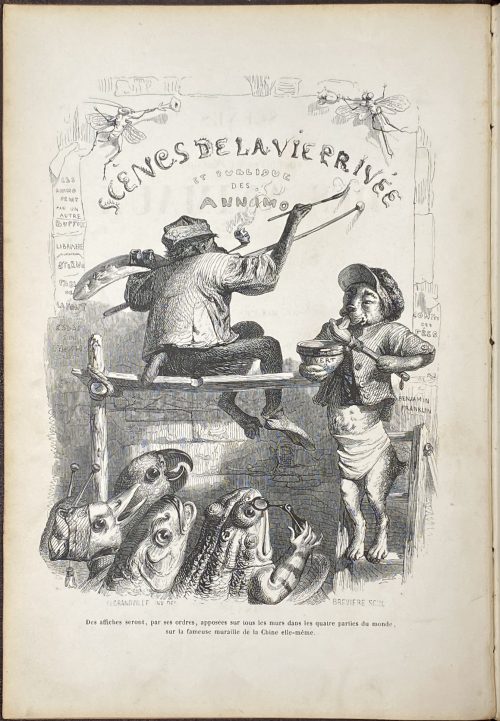 A two-volume set in the contemporary full calf, imitating the editorial cloth binding. Vol. 1: SCÈNES | DE LA | VIE PRIVÉE ET PUBLIQUE | DES ANIMAUX | VIGNETTES | PAR GRANDVILLE. | — | ÉTUDES DE MŒURS CONTEMPORAINES | PUBLIÉES | SOUS LA DIRECTION DE M. P. – J. STAHL , | AVEC LA COLLABORATION | DE MESSIEURS | DE BALZAC. – L. BAUDE. – E. DE LA BEDOLLIERE. – P. BERNARD. – J. JANIN. | ED. LEMOINE. – CHARLES NODIER. – GEORGE SAND. | [VIGNETTE] | PARIS. | J. HETZEL ET PAULIN , ÉDITEURS , | RUE DE SEINE-SAINT-GERMAIN , 33. | 1842 Pagination: [2 blanks] [2 - ht. / imprim.] [2 - blank / frontis.] [2 - t.p. / blank] [4] [1] 2-386 [6 - table] [2 blanks], 96 whole-page wood-engravings after Grandville, vignettes within the text including head and tailpieces, together with a frontispiece. VOL. 2: SCÈNES | DE LA | VIE PRIVÉE ET PUBLIQUE | DES ANIMAUX | VIGNETTES | PAR GRANDVILLE. | — | ÉTUDES DE MŒURS CONTEMPORAINES | PUBLIÉES | SOUS LA DIRECTION DE M. P. – J. STAHL , | AVEC LA COLLABORATION | DE | MM. DE BALZAC, – L' HERITIER (DE L' AIN), – ALFRED DE MUSSET – PAUL DE MUSSET, | CHARLES NODIER, – MADAME M. MENESSIER NODIER, – LOUIS VIARDOT. | [VIGNETTE] | PARIS, | J. HETZEL , ÉDITEUR , | RUE DE SEINE-SAINT-GERMAIN , 33. | 1842 Pagination: [2 - ht. / imprim.] [2 - blank / frontis.] [2 - t.p. / blank] [1] 2-390 [6 - table], 105 whole-page wood-engravings after Grandville, vignettes within the text including head and tailpieces, together with a frontispiece. Size: Each volume 27 x 18 cm; In-4to (usually classified as 8vo, however, the numeric signatures provide for gathering in-quarto). Binding: Full burgundy calf, gilt embossed Grandville's characters to boards and spine, lettering to spine, white moire end-papers to vol. 1, and yellow end-papers to vol. 2, all margins gilt. Combination of the 1st and 2nd print-runs of the 1st edition. Ref.: L. Carteret, 1927: pp. 552-558. Wikipedia; Gallica; Hathi Trust. In: British Museum, MET, RISD Museum, Fine Arts Museums of San Francisco.
A two-volume set in the contemporary full calf, imitating the editorial cloth binding. Vol. 1: SCÈNES | DE LA | VIE PRIVÉE ET PUBLIQUE | DES ANIMAUX | VIGNETTES | PAR GRANDVILLE. | — | ÉTUDES DE MŒURS CONTEMPORAINES | PUBLIÉES | SOUS LA DIRECTION DE M. P. – J. STAHL , | AVEC LA COLLABORATION | DE MESSIEURS | DE BALZAC. – L. BAUDE. – E. DE LA BEDOLLIERE. – P. BERNARD. – J. JANIN. | ED. LEMOINE. – CHARLES NODIER. – GEORGE SAND. | [VIGNETTE] | PARIS. | J. HETZEL ET PAULIN , ÉDITEURS , | RUE DE SEINE-SAINT-GERMAIN , 33. | 1842 Pagination: [2 blanks] [2 - ht. / imprim.] [2 - blank / frontis.] [2 - t.p. / blank] [4] [1] 2-386 [6 - table] [2 blanks], 96 whole-page wood-engravings after Grandville, vignettes within the text including head and tailpieces, together with a frontispiece. VOL. 2: SCÈNES | DE LA | VIE PRIVÉE ET PUBLIQUE | DES ANIMAUX | VIGNETTES | PAR GRANDVILLE. | — | ÉTUDES DE MŒURS CONTEMPORAINES | PUBLIÉES | SOUS LA DIRECTION DE M. P. – J. STAHL , | AVEC LA COLLABORATION | DE | MM. DE BALZAC, – L' HERITIER (DE L' AIN), – ALFRED DE MUSSET – PAUL DE MUSSET, | CHARLES NODIER, – MADAME M. MENESSIER NODIER, – LOUIS VIARDOT. | [VIGNETTE] | PARIS, | J. HETZEL , ÉDITEUR , | RUE DE SEINE-SAINT-GERMAIN , 33. | 1842 Pagination: [2 - ht. / imprim.] [2 - blank / frontis.] [2 - t.p. / blank] [1] 2-390 [6 - table], 105 whole-page wood-engravings after Grandville, vignettes within the text including head and tailpieces, together with a frontispiece. Size: Each volume 27 x 18 cm; In-4to (usually classified as 8vo, however, the numeric signatures provide for gathering in-quarto). Binding: Full burgundy calf, gilt embossed Grandville's characters to boards and spine, lettering to spine, white moire end-papers to vol. 1, and yellow end-papers to vol. 2, all margins gilt. Combination of the 1st and 2nd print-runs of the 1st edition. Ref.: L. Carteret, 1927: pp. 552-558. Wikipedia; Gallica; Hathi Trust. In: British Museum, MET, RISD Museum, Fine Arts Museums of San Francisco.


